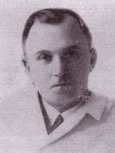
Michael Dov Weissmandl was an Orthodox rabbi of the Oberlander Jews of present-day western Slovakia. Along with Gisi Fleischmann he was the leader of the Bratislava Working Group which attempted to save European Jews from deportation to Nazi death camps during the Holocaust and was the first person to urge Allied powers to bomb the railways leading to concentration camp gas chambers. Managing to escape from a sealed cattle car headed for Auschwitz in 1944, he later emigrated to America where he established a yeshiva and self-sustaining agricultural community in New York known as the Yeshiva Farm Settlement. Accusing the Zionist Jewish Agency of having frustrated his rescue efforts during the Holocaust, he became a staunch opponent of Zionism after the war. Weissmandl claimed to have discovered codes in the Biblical text.

Neologs are one of the two large communal organizations among Hungarian Jewry. Socially, the liberal and modernist Neologs had been more inclined toward integration into Hungarian society since the Era of Emancipation in the 19th century. This was their main feature, and they were largely the representative body of urban, assimilated middle- and upper-class Jews. Religiously, the Neolog rabbinate was influenced primarily by Zecharias Frankel's Positive-Historical School, from which Conservative Judaism evolved as well, although the formal rabbinical leadership had little sway over the largely assimilationist communal establishment and congregants. Their rift with the traditionalist and conservative Orthodox Jews was institutionalized following the 1868–1869 Hungarian Jewish Congress, and they became a de facto separate denomination. The Neologs remained organizationally independent in those territories ceded under the terms of the 1920 Treaty of Trianon, and are still the largest group among Hungary's Jews.
Rabbi Shmuel Dovid Ungar, also known as Rabbi Samuel David Ungar, was the rabbi of the Hungarian city of Nyitra and dean of the last surviving yeshiva in occupied Europe during World War II. He was the father-in-law of Rabbi Chaim Michael Dov Weissmandl, and played a minor role in the Bratislava Working Group's efforts to save Slovak Jews from the Holocaust.

The history of the Jews in Croatia dates back to at least the 3rd century, although little is known of the community until the 10th and 15th centuries. According to the 1931 census, the community numbered 21,505 members, and it is estimated that on the eve of the Second World War the population was around 25,000 people. Most of the population was murdered during the Holocaust that took place on the territory of the Nazi puppet state called the Independent State of Croatia. After the war, half of the survivors chose to settle in Israel, while an estimated 2,500 members continued to live in Croatia. According to the 2011 census, there were 509 Jews living in Croatia, but that number is believed to exclude those born of mixed marriages or those married to non-Jews. More than 80 percent of the Zagreb Jewish Community were thought to fall in those two categories.
Erlau, is a Haredi dynasty of Hungarian origin, which follows the teachings of the Chasam Sofer and is often considered Hasidic.

The Holocaust in the Independent State of Croatia involved the genocide primarily of Jews, and also the genocide of Serbs and Romani (Porajmos), within the Independent State of Croatia, a fascist puppet state which existed during World War II, was led by the Ustaše regime, and ruled an occupied area of Yugoslavia which included most of the territory of modern-day Croatia, the whole of modern-day Bosnia and Herzegovina and the eastern part of Syrmia (Serbia). Of the 39,000 Jews who lived in the NDH in 1941, the United States Holocaust Memorial Museum states that more than 30,000 were murdered. Of these, 6,200 were shipped to Nazi Germany and the rest of them were murdered in the NDH, the vast majority in Ustaše-run concentration camps, such as Jasenovac. The Ustaše were the only quisling forces in Europe who operated their own extermination camps for the purpose of murdering Jews and members of other ethnic groups.

Chaim Sofer was a renowned Hungarian rabbi and "scholarly spokesperson for Orthodox Judaism during his time."

Retfala is a city district in the western part of Osijek, Croatia. It has 14,123 inhabitants distributed in 5,200 households. It borders Gornji grad to the east, Tvrđavica to the northeast, Višnjevac to the west and Industrijska četvrt to the south.

Miroslav Šalom Freiberger was a Croatian chief rabbi, translator, writer and spiritual leader. He was educated as a lawyer and doctor of theology.

Lav Mirski was a Croatian-Jewish conductor.

Mavro "Moše" Frankfurter (1875–1942) was a Croatian rabbi from Vinkovci who was murdered during the Holocaust at the Jasenovac concentration camp.
Arnold Kohn was a Croatian Zionist, longtime president of the Jewish community Osijek and Holocaust survivor.

Dr. Slavko Wolf was a Croatian lawyer, chess player and writer.

Dr. Slavko Hirsch was a Croatian physician, founder and director of the Epidemiological Institute in Osijek.
Dr. Karlo Weissmann was a Croatian physician and founder of the first sanatorium in Osijek.

Mirko Herrmann was a Croatian industrialist, businessman and member of the Freemasonry in Osijek, Croatia.
Herman Ehrlich was a Croatian architect and businessman.

Ing. Mihajlo Klajn was a Yugoslav agronomist and communist who was killed during the Holocaust in the Independent State of Croatia.

The Tenja concentration camp was one of 26 concentration camps established in the Independent State of Croatia during World War II. It was located close to village of Tenja near Osijek and operated by Ustaše.













